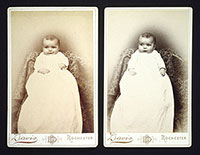How you are storing your important documents and family heirlooms can dictate their condition for future generations. This tutorial will discuss the "best" way to archive these priceless items.
This is really not that much of a tutorial as it is informational, but these tips can help you save some of those important family documents and photographs that you would like to pass down from generation to generation.
We all know that we live in a "digital" age, and most people take pictures on their cell phones and digital cameras. Hopefully, those important photographs are at least backed up someplace, but what about those that were handed down to you from previous generations or that you had printed off?
Make a Digital Copy
One suggestion is to take those photos and documents, and make a digital copy. Scan them, take a photo of them, whatever you have to do in order to get a digital copy is highly recommended. You do not know how those items were treated in the past, and would be surprised of their condition in the future. So, if you get a chance, make a digital copy.
Once you have that digital copy, you can then share it with other family members, make additional printed copies, or just keep it backed up with your other digital photos and documents for future use.
Storing the Originals
The biggest threat to these documents is the document themselves and the chemicals that were used to produce them. It is the chemicals that we need to be concerned with having reactions to temperture, humidity, or other chemicals that can totally destroy a document.
Here are some tips when it comes to archiving those documents:
Store items at a low temperature and a low relative humidity:
- The lower the temperature, the longer the items will last. Cooler temperatures will slow the rate of chemical decay and reduce insect activity. Keep the temps below 75 degrees Fahrenheit when possible.
- Keep the relative humidity below 65% to prevent mold growth and reduce insect activity.
- Avoid very low relative humidity because relative humidity below 15% can cause brittleness.
Consider cold storage for acetate negatives, color negatives, prints, and slides
- Acetate negatives and color negatives, slides, and prints are vulnerable to fading and deterioration within just decades, if they are stored at room temperature. Cold storage can slow this deterioration, but it requires some special packaging and steps. The National Park Service has an entire website dedicated to cold storage procedures. You can review them here.
Reduce the risk of damage form water, insects, and rodents
- Store items out of damp basements, garages, or hot attics. You might say, well that is where my storage is located. You might be right, but that is not the ideal places to store grandma's photographs.
- Keep items away from sources of leaks and floods, such as pipes, windows, or known roof leaks. You might also want to consider the location of the pipes to your bathroom. Are you storing family documents in a closet that is next to the shower?
- Keep the items up off the floor. A shelf in a closet or in your bedroom is an ideal place to keep these items stored.
- Store these items away from food or water sources which are very attractive to insects and rodents. It would be devastating to see your family photos being used as nesting materials.
If you have some other tips, let us know. Leave them in the comments section below.
Source: https://www.archives.gov/preservation/family-archives/storing.html


No comments:
Post a Comment